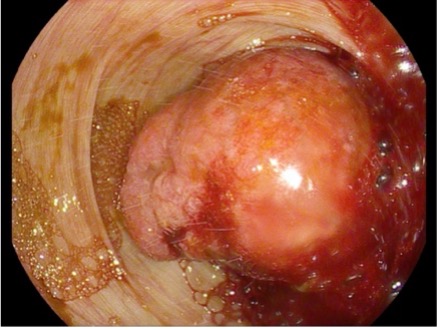Tuesday Poster Session
Category: Colorectal Cancer Prevention
P4815 - A Rare Case of a Right-Sided Neuroendocrine Tumor Presenting With Both Upper and Lower Gastrointestinal Bleeding
Tuesday, October 28, 2025
10:30 AM - 4:00 PM PDT
Location: Exhibit Hall

Wilfredo Torres Mata, Jr., MD
Negros Oriental Provincial Hospital
Dumaguete City, Negros Oriental, Philippines
Presenting Author(s)
Wilfredo Torres. Mata, MD, Angelica Gallespen, MD, Jacky Vincent Omandam, MD, Aldin Legaspi, MD, Maria Joscel Torres, MD
Negros Oriental Provincial Hospital, Dumaguete City, Negros Oriental, Philippines
Introduction: Neuroendocrine tumors (NETs) are rare neoplasms, with right-sided colonic NETs being particularly uncommon. These tumors are often asymptomatic and diagnosed late, typically presenting with abdominal discomfort, obstruction, or weight loss. Hematochezia is rarely reported, as colonic NETs grow exophytically rather than ulcerate. More aggressive types, like neuroendocrine carcinomas or rectal NETs, are more likely to bleed. According to WHO 2019, NETs are classified as well-differentiated (G1–G3) or poorly differentiated (NECs). This case describes a 62-year-old female with a well-differentiated right-sided colonic NET who initially presented with melena which eventually progressed to hematochezia. Early diagnosis enabled timely surgery and favorable prognosis.
Case Description/
Methods: A 62-year-old female with hypertension and diabetes presented with 3 months of melena and severe epigastric pain. Endoscopy showed hiatal hernia, bile reflux, antral ulcers, and duodenitis; biopsies revealed chronic active gastritis. Despite treatment, she developed hematochezia and was re-admitted. Colonoscopy showed a nearly obstructing ascending colon mass. She underwent right hemicolectomy; pathology confirmed a well-differentiated NET, WHO grade I, with 1/7 node metastasis. Post-op, a hepatic lesion was noted on CT. Surveillance continues, and she remains asymptomatic with an ECOG score of 0 and a Karnofsky score of 100, indicating excellent health with no disease-related limitations.
Discussion: Neuroendocrine tumors (NETs) arise from abnormal APUD cell proliferation, often in the lung, rectum, or small bowel. Colonic NETs, especially right-sided, are rare and often asymptomatic until late, sometimes presenting with GI bleeding. Our patient had an ascending colon NET with cecal and appendiceal involvement, stage III, well-differentiated, per WHO 2019. Surgery is the mainstay for non-metastatic cases, but recurrence risk remains high, especially in the liver. Despite limited resources, ongoing surveillance is critical, as our patient, now 25 months post-op, remains asymptomatic with stable hepatic findings. Early diagnosis allowed timely intervention, emphasizing the need for improved screening and prompt management of rare gastrointestinal tumors like NETs.

Figure: Colonoscopy showing a irregularly shaped polypoid mass in the ascending colon with significant narrowing of the lumen.

Figure: On immunohistochemistry, tumor cells were positive for Chromogranin (A), Synaptophysin (B), and CD56 (C) with Ki-67 of less than 1% (D).
Disclosures:
Wilfredo Mata indicated no relevant financial relationships.
Angelica Gallespen indicated no relevant financial relationships.
Jacky Vincent Omandam indicated no relevant financial relationships.
Aldin Legaspi indicated no relevant financial relationships.
Maria Joscel Torres indicated no relevant financial relationships.
Wilfredo Torres. Mata, MD, Angelica Gallespen, MD, Jacky Vincent Omandam, MD, Aldin Legaspi, MD, Maria Joscel Torres, MD. P4815 - A Rare Case of a Right-Sided Neuroendocrine Tumor Presenting With Both Upper and Lower Gastrointestinal Bleeding, ACG 2025 Annual Scientific Meeting Abstracts. Phoenix, AZ: American College of Gastroenterology.
Negros Oriental Provincial Hospital, Dumaguete City, Negros Oriental, Philippines
Introduction: Neuroendocrine tumors (NETs) are rare neoplasms, with right-sided colonic NETs being particularly uncommon. These tumors are often asymptomatic and diagnosed late, typically presenting with abdominal discomfort, obstruction, or weight loss. Hematochezia is rarely reported, as colonic NETs grow exophytically rather than ulcerate. More aggressive types, like neuroendocrine carcinomas or rectal NETs, are more likely to bleed. According to WHO 2019, NETs are classified as well-differentiated (G1–G3) or poorly differentiated (NECs). This case describes a 62-year-old female with a well-differentiated right-sided colonic NET who initially presented with melena which eventually progressed to hematochezia. Early diagnosis enabled timely surgery and favorable prognosis.
Case Description/
Methods: A 62-year-old female with hypertension and diabetes presented with 3 months of melena and severe epigastric pain. Endoscopy showed hiatal hernia, bile reflux, antral ulcers, and duodenitis; biopsies revealed chronic active gastritis. Despite treatment, she developed hematochezia and was re-admitted. Colonoscopy showed a nearly obstructing ascending colon mass. She underwent right hemicolectomy; pathology confirmed a well-differentiated NET, WHO grade I, with 1/7 node metastasis. Post-op, a hepatic lesion was noted on CT. Surveillance continues, and she remains asymptomatic with an ECOG score of 0 and a Karnofsky score of 100, indicating excellent health with no disease-related limitations.
Discussion: Neuroendocrine tumors (NETs) arise from abnormal APUD cell proliferation, often in the lung, rectum, or small bowel. Colonic NETs, especially right-sided, are rare and often asymptomatic until late, sometimes presenting with GI bleeding. Our patient had an ascending colon NET with cecal and appendiceal involvement, stage III, well-differentiated, per WHO 2019. Surgery is the mainstay for non-metastatic cases, but recurrence risk remains high, especially in the liver. Despite limited resources, ongoing surveillance is critical, as our patient, now 25 months post-op, remains asymptomatic with stable hepatic findings. Early diagnosis allowed timely intervention, emphasizing the need for improved screening and prompt management of rare gastrointestinal tumors like NETs.

Figure: Colonoscopy showing a irregularly shaped polypoid mass in the ascending colon with significant narrowing of the lumen.

Figure: On immunohistochemistry, tumor cells were positive for Chromogranin (A), Synaptophysin (B), and CD56 (C) with Ki-67 of less than 1% (D).
Disclosures:
Wilfredo Mata indicated no relevant financial relationships.
Angelica Gallespen indicated no relevant financial relationships.
Jacky Vincent Omandam indicated no relevant financial relationships.
Aldin Legaspi indicated no relevant financial relationships.
Maria Joscel Torres indicated no relevant financial relationships.
Wilfredo Torres. Mata, MD, Angelica Gallespen, MD, Jacky Vincent Omandam, MD, Aldin Legaspi, MD, Maria Joscel Torres, MD. P4815 - A Rare Case of a Right-Sided Neuroendocrine Tumor Presenting With Both Upper and Lower Gastrointestinal Bleeding, ACG 2025 Annual Scientific Meeting Abstracts. Phoenix, AZ: American College of Gastroenterology.
